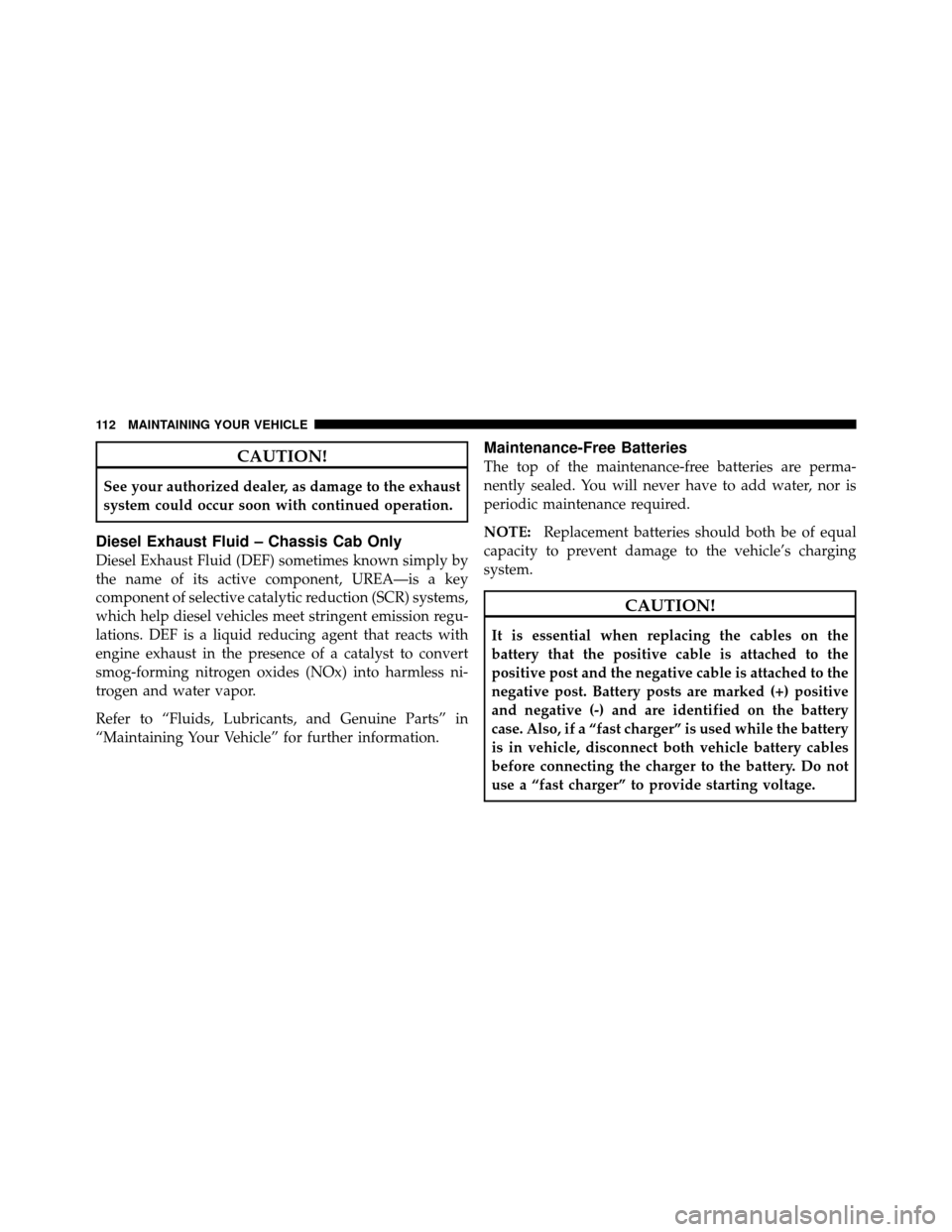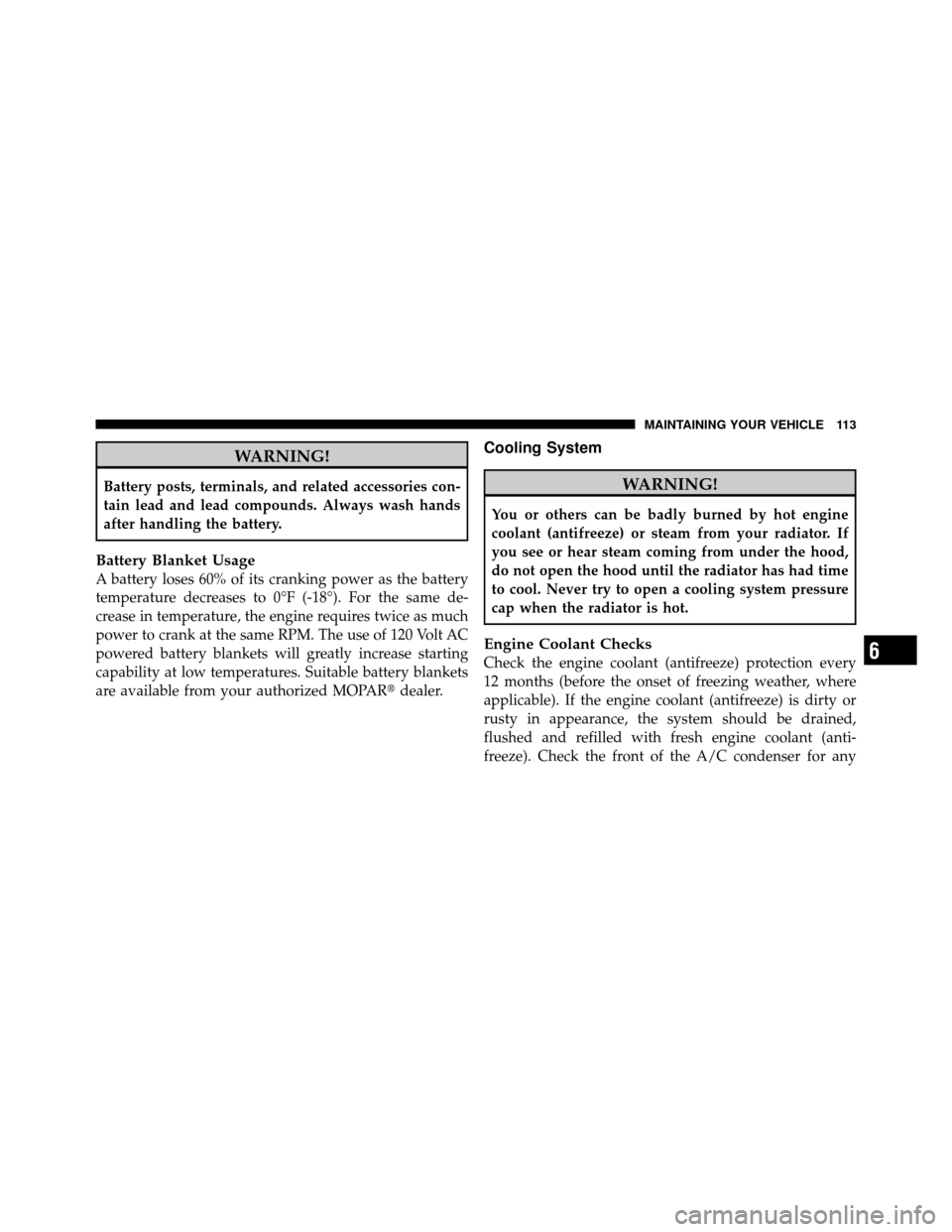Page 94 of 170
WARNING!
Any procedure other than above could result in:
•Personal injury caused by electrolyte squirting out
the battery vent;
•Personal injury or property damage due to battery
explosion;
•Damage to charging system of booster vehicle or
of immobilized vehicle.
With Portable Starting Unit
There are many types of these units available. Follow the
manufacturer’s instructions for necessary precautions
and operation.
CAUTION!
It is very important that the starting unit operating
voltage does not exceed 12 Volts DC or damage to
battery, starter motor, alternator, or electrical system
may occur.
5
WHAT TO DO IN EMERGENCIES 93
Page 98 of 170
ENGINE COMPARTMENT — 6.7L DIESEL
1 — Battery7 — Engine Oil Dipstick
2 — Engine Coolant Reservoir 8 — Washer Fluid Reservoir
3 — Automatic Transmission Dipstick (If Equipped) 9 — Engine Oil Fill
4 — Brake Fluid Reservoir 10 — Coolant Pressure Cap
5 — Clutch Master Cylinder (Manual Transmission Only) 11 — Air Cleaner Filter
6 — Integrated Power Module
6
MAINTAINING YOUR VEHICLE 97
Page 113 of 170

CAUTION!
See your authorized dealer, as damage to the exhaust
system could occur soon with continued operation.
Diesel Exhaust Fluid – Chassis Cab Only
Diesel Exhaust Fluid (DEF) sometimes known simply by
the name of its active component, UREA—is a key
component of selective catalytic reduction (SCR) systems,
which help diesel vehicles meet stringent emission regu-
lations. DEF is a liquid reducing agent that reacts with
engine exhaust in the presence of a catalyst to convert
smog-forming nitrogen oxides (NOx) into harmless ni-
trogen and water vapor.
Refer to “Fluids, Lubricants, and Genuine Parts” in
“Maintaining Your Vehicle” for further information.
Maintenance-Free Batteries
The top of the maintenance-free batteries are perma-
nently sealed. You will never have to add water, nor is
periodic maintenance required.
NOTE:Replacement batteries should both be of equal
capacity to prevent damage to the vehicle’s charging
system.
CAUTION!
It is essential when replacing the cables on the
battery that the positive cable is attached to the
positive post and the negative cable is attached to the
negative post. Battery posts are marked (+) positive
and negative (-) and are identified on the battery
case. Also, if a “fast charger” is used while the battery
is in vehicle, disconnect both vehicle battery cables
before connecting the charger to the battery. Do not
use a “fast charger” to provide starting voltage.
112 MAINTAINING YOUR VEHICLE
Page 114 of 170

WARNING!
Battery posts, terminals, and related accessories con-
tain lead and lead compounds. Always wash hands
after handling the battery.
Battery Blanket Usage
A battery loses 60% of its cranking power as the battery
temperature decreases to 0°F (-18°). For the same de-
crease in temperature, the engine requires twice as much
power to crank at the same RPM. The use of 120 Volt AC
powered battery blankets will greatly increase starting
capability at low temperatures. Suitable battery blankets
are available from your authorized MOPAR�dealer.
Cooling System
WARNING!
You or others can be badly burned by hot engine
coolant (antifreeze) or steam from your radiator. If
you see or hear steam coming from under the hood,
do not open the hood until the radiator has had time
to cool. Never try to open a cooling system pressure
cap when the radiator is hot.
Engine Coolant Checks
Check the engine coolant (antifreeze) protection every
12 months (before the onset of freezing weather, where
applicable). If the engine coolant (antifreeze) is dirty or
rusty in appearance, the system should be drained,
flushed and refilled with fresh engine coolant (anti-
freeze). Check the front of the A/C condenser for any6
MAINTAINING YOUR VEHICLE 113
Page 163 of 170

Adding Fuel............................ 83
Air Cleaner, Engine (Engine Air Cleaner
Filter) ............................. 102,126
Air Filter .............................. 102
Airbag Light ............................ 19
Antifreeze (Engine Coolant) .............. 114,115
Capacities ........................... 130
Disposal ............................ 117
Anti-Lock Warning Light ................... 19
Automatic Transmission .................... 68
Adding Fluid ......................... 122
Fluid Level Check ..................... 122
Fluid Type ........................ 122,133
Shifting .............................. 62
Axle Fluid ............................. 133
Battery ............................... 112
Blanket ........................... 51,113
Emergency Starting ..................... 90 Brake Fluid
............................ 133
Brake System ........................... 119
Fluid Check .......................... 119
Master Cylinder ....................... 119
Warning Light ......................... 14
Brake/Transmission Interlock ................ 61
Calibration, Compass ...................... 33
Capacities, Antifreeze (Engine Coolant) ........ 130
Capacities, Fluid ........................ 130
Caps, Filler Oil (Engine) .......................... 100
Radiator (Coolant Pressure) ............... 116
Charge Air Cooler ....................... 119
Check Engine Light (Malfunction Indicator
Light) ................................. 18
Compass .............................. 32
Compass Calibration ...................... 33
Compass Variance ........................ 33
162 INDEX